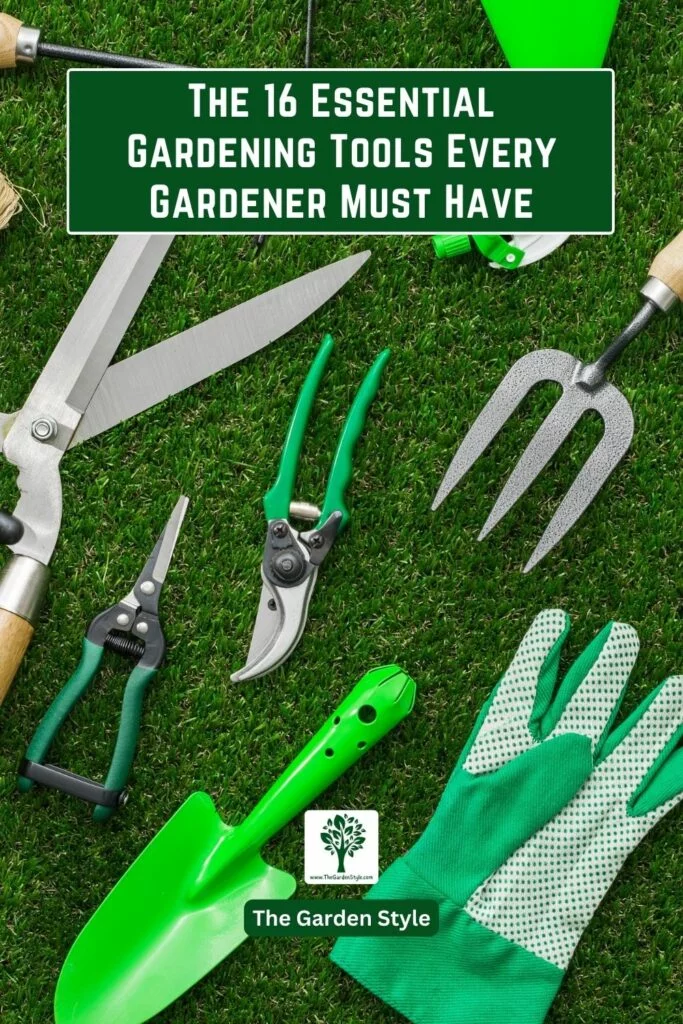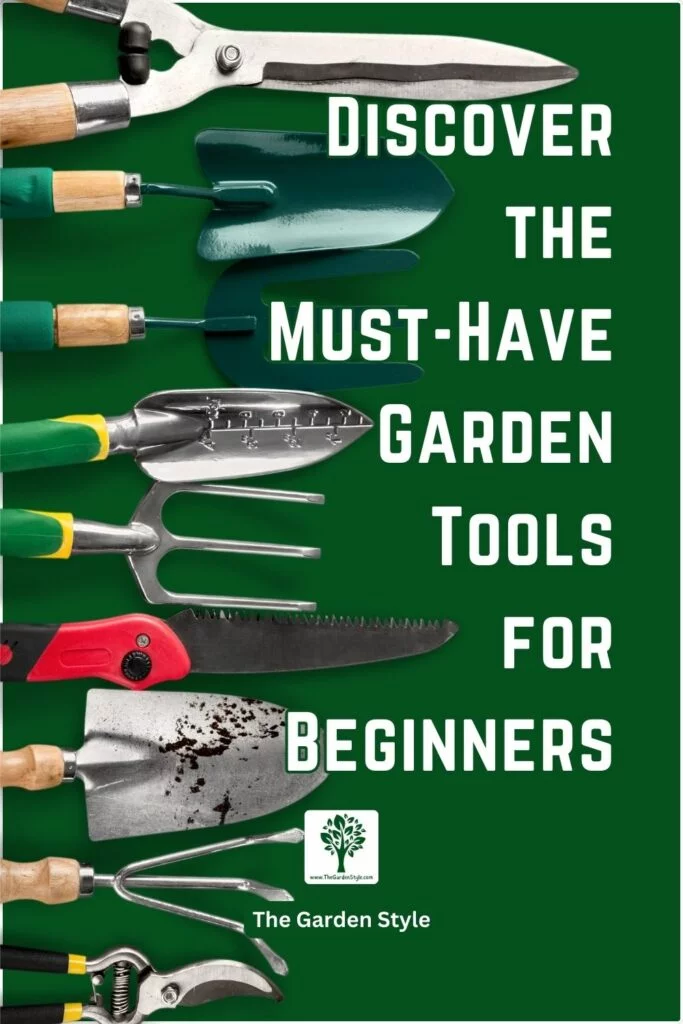Gardening is a therapeutic and rewarding endeavor, but to truly cultivate a thriving green space, having the right tools is key. In this guide, we’ll explore the 16 essential gardening tools that every gardener, from beginners to seasoned enthusiasts, should have in their arsenal. From soil preparation to plant care, we’ll delve into the functionalities and nuances of each tool, ensuring you’re well-equipped for a flourishing garden.
Table of Contents
The Must-Have Gardening Tools
In this article, you will find 16 garden tools with their names and pictures, classified according to their use in the garden.
- Soil Preparation: Spade, Garden Fork, Garden Rake
- Planting and Seed Sowing: Hand Trowel, Garden Hoe
- Weeding and Cultivating: Hand Weeder, Garden Hoe
- Watering: Watering Can, Garden Sprayer
- Pruning and Cutting: Pruner, Hand Pruners, Gardening Gloves and Safety Glasses
- Harvesting: Hand Trowel
- Caring: Gardening Gloves, Knee Pads
- Protective Gear: Sun Hat, Sunscreen
Essential Garden Tools for Soil Preparation
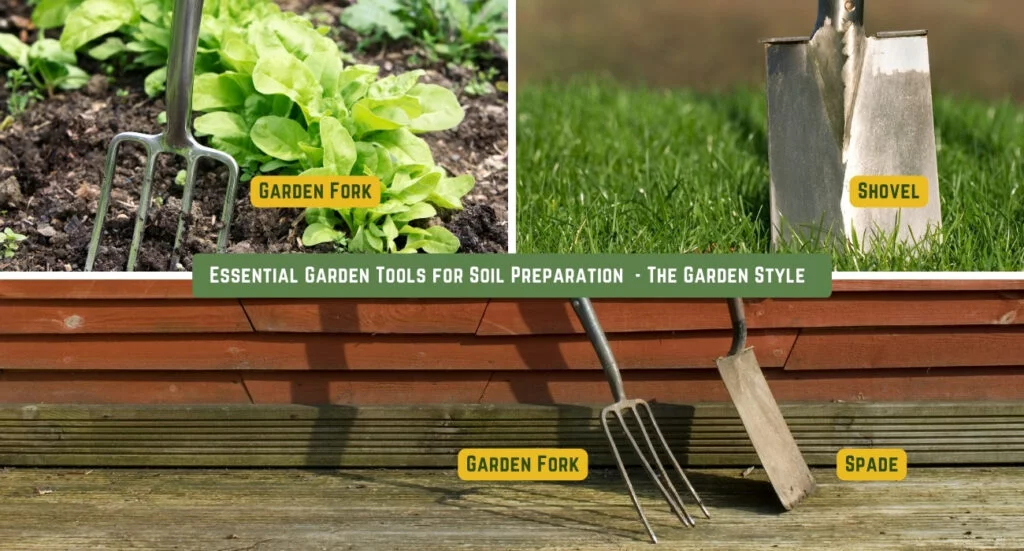
Spade
A spade is a garden tool characterized by a flat, square-ended blade attached to a relatively short handle. It is designed for digging, lifting, and moving soil and other materials in the garden. Depending on your garden activities, you may not need a spade, but a hand trowel may be enough.
To use a spade, grip the handle firmly, position the blade at the desired spot, and push it into the soil. Use your foot to apply downward pressure on the blade, allowing it to cut through the soil. Lift and turn the soil as needed. Spades are versatile and can also be used for tasks like transplanting, edging, and dividing perennials. Spades are for digging, and shovels are for moving.
Tip Before Buying: When purchasing a spade, consider the quality of the blade material and handle construction. Look for a spade with a durable, rust-resistant blade made of materials like stainless steel or tempered carbon steel. Additionally, choose a spade with a handle that feels comfortable in your hands, ensuring a secure grip during extended use.
Garden Fork
The garden fork is a powerhouse for breaking up soil, aerating, and turning compost.
Insert the garden fork into the soil, tilt it backward, and lift it to loosen and aerate the ground. This simple technique enhances soil structure, allowing better water and nutrient penetration for healthier and more robust plant growth.
Tip for choosing the best garden fork: Look for sturdy tines and a comfortable handle grip for efficient use. Alternative: soil fork, compost fork, aeration fork.
Garden Rake
A garden rake is indispensable for leveling soil, removing debris, and preparing the ground for planting.
Simply hold the rake handle and pull it toward you to collect leaves, rocks, and other debris. This easy motion streamlines the process of tidying up your garden, ensuring the efficient removal of unwanted materials.
To spread new mulch in your garden, begin by using a rake to remove any debris or old mulch, ensuring a clean surface. Employ a shovel or wheelbarrow to transport the fresh mulch to the desired areas. With a rake, mulch spreader, or simply by hand, evenly distribute the new mulch landscaping or around your garden beds, creating a layer approximately 2 to 4 inches thick, depending on the type of mulch selected.
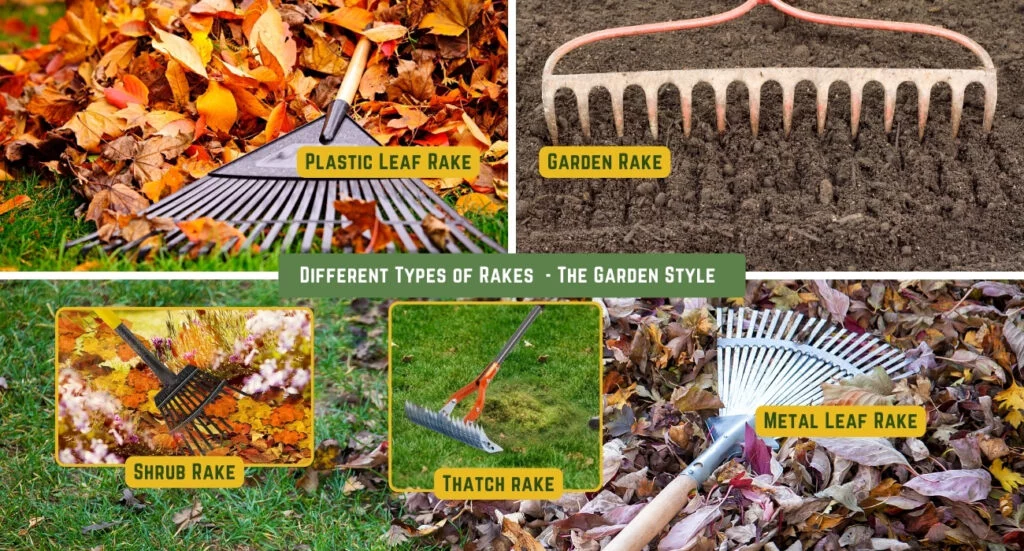
While we have highlighted the garden rake as an essential tool for various outdoor activities, it’s important to note that the selection process should be tailored to your specific gardening needs. There are different types of garden rakes designed to address specific tasks, and choosing the right one can significantly enhance your efficiency. For instance, options such as the shrub rake, thatch rake, plastic leaf rake, metal leaf rake, and garden rake serve distinct purposes.
The shrub rake is ideal for working in tight spaces among plants, the thatch rake helps remove thatch from the lawn, the plastic leaf rake is lightweight and suitable for collecting leaves, the metal leaf rake provides durability for heavier debris, and the garden rake is a versatile tool for general garden maintenance. Therefore, when considering the purchase of a garden rake, it is advisable to assess your garden activities and, if necessary, invest in more than one type to ensure you have the right tool for each task at hand.
Tip for choosing the best garden rake for you: opt for a rake with sturdy tines and an ergonomic handle for ease of use. Assess your garden activities to choose the right one.
Alternative: leaf rake, soil rake, debris rake.
Gardening Tools for Planting, Weeding, Sowing, and Harvesting
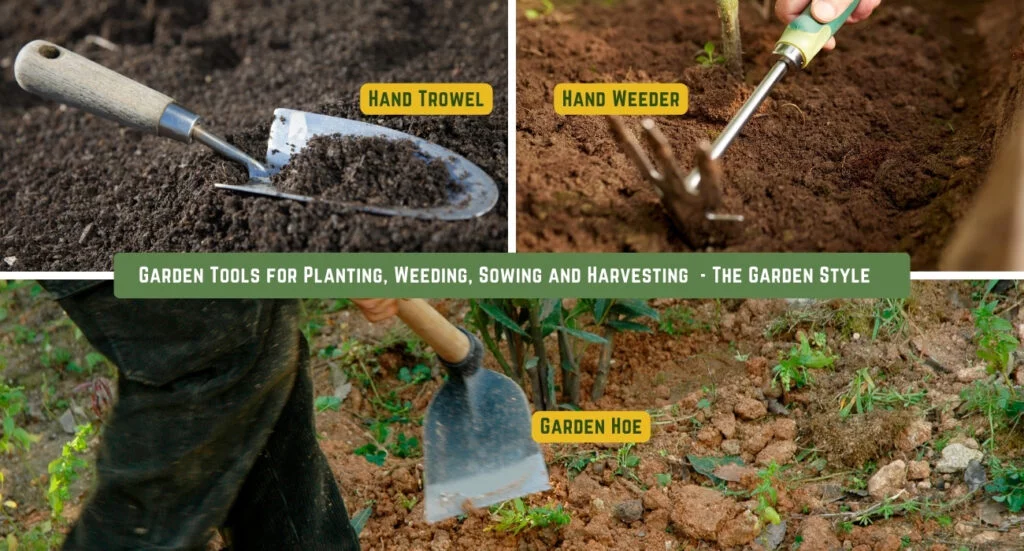
Hand Trowel
The hand trowel is a must-have garden tool for every gardener. It is used for digging, planting, and weeding in small spaces. Grip the handle firmly, insert the trowel into the soil, and lift it to create a hole for planting or uprooting weeds.
Tip before buying: Look for a sturdy, lightweight, and ergonomic design with a comfortable grip for prolonged use.
Alternative: digging trowel, planting trowel, weeding trowel.
Garden Hoe
The garden hoe is designed to cultivate soil, chop weeds, and create furrows for planting.
To effectively use the hoe, employ a rhythmic swinging motion. Begin by positioning the hoe over the targeted area, then swing it back and forth. This deliberate action serves two purposes: breaking up compacted soil and effortlessly cutting through pesky weeds. The back-and-forth movement helps loosen the soil, making it more conducive for plant growth while simultaneously dealing with any unwanted vegetation. Remember to maintain a comfortable grip on the handle, allowing the hoe to do the hard work as you guide it through the soil. This technique ensures a productive and efficient gardening experience.
How to choose: look for a hoe with a sharp blade, durable construction, and an ergonomic handle to reduce strain on the hands and wrists.
Hand Weeder
For a beginner gardener, a must-have tool designed explicitly for weeding is the hand weeder. This tool is versatile, easy to use, and effective for removing weeds with their roots intact. It typically has a forked end that allows you to dig into the soil, grab hold of the weed, and pull it out, minimizing the chances of regrowth.
The hand weeder is ideal for small to medium-sized gardens and is particularly useful for precision weeding in tight spaces, around established plants, and in flower beds. Its simplicity makes it a great introductory tool for someone new to gardening, providing practical and hands-on experience in tackling common weeding tasks.
- PLAY22 GARDEN TOOLS SET includes a weeder, hand fork, hand rake, transplanter, trowel, pruner, spray bottle, and a pair of gloves – complete garden hand
Gardening Tools for Watering
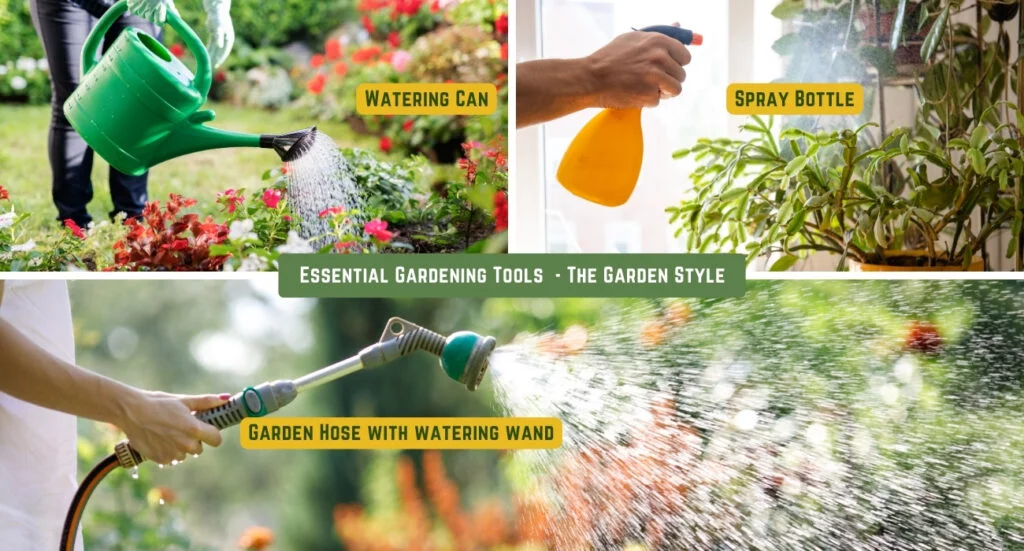
Watering Can
A watering can ensure precise and controlled watering for different plants. Fill the can with water, aim at the base of the plants, and water evenly. Before buying, select a can with a long spout for accurate watering. Also, choose cans with a comfortable handle and a design that minimizes strain on the wrists.
An alternative to a watering can in the garden is a soaker hose or a garden hose with an adjustable nozzle or a watering wand. Soaker hoses deliver a gentle, consistent flow of water directly to the base of plants, promoting efficient and deep watering. A garden hose with an adjustable nozzle allows you to control the water flow, making it versatile for different watering needs in the garden.
Alternative: watering pot, drip irrigation system.
Recommended reading: How to Save Water in the Garden
Garden Sprayer
A garden sprayer is essential for applying fertilizers, pesticides, and herbicides to plants.
Firstly, start by filling the sprayer with the solution that best suits your gardening needs – whether it’s a nutrient-rich fertilizer, a targeted pesticide, or a protective herbicide. Once the reservoir is filled, the next step involves pumping or employing the pressurization mechanism, depending on the design of your sprayer.
How to choose: Opt for a sprayer with adjustable nozzles and a comfortable grip for precise application.
Alternative: plant sprayer for mist, liquid applicator, fertilizer sprayer.
Recommended reading: The WORST Time to Water Plants
Gardening Tools for Pruning and Trimming
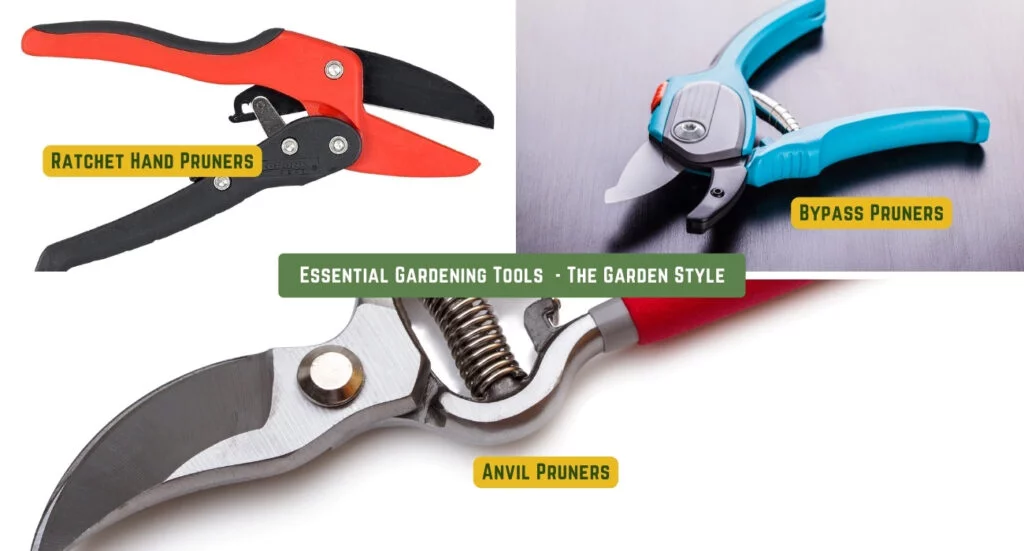
Pruners, Hand Pruners, Bypass Pruners, Secateurs
Pruners, or hand pruners, also known as secateurs, are ideal for precision pruning of small branches and stems. Pruning shears are essential for maintaining plant health by trimming branches, deadheading flowers, and shaping bushes. To operate the pruners effectively, start by opening the tool. Next, position the pruners around the branch you intend to trim, and then apply gentle pressure to achieve a precise and clean cut.
Alternative: secateurs, hand clippers, trimming shears, ratchet pruning shears, bypass pruners, hand clippers, trimming scissors, ratchet pruners.
Keeping pruning shears clean and sharpened is essential; follow the link to learn how to do it right.
Tips: Opt for shears with a sharp blade, a comfortable grip, and a safety lock to prevent accidents. Select pruners with a bypass-cutting mechanism, sharp blades, and a comfortable grip or even ergonomic handles. If you have arthritis, opt for models with a ratcheting mechanism called ratchet pruners or ratchet hand pruners, which reduces the effort required. Corona Tools offers high-quality ratchet hand pruners that require minimal hand effort for efficient and easy use.
- Rachet Pruner: designed for reduced effort and fatigue when cutting larger branches. Allows you to stop mid-cut, open back up for more leverage, and continue cut.
Loopers
Although not included on our must-have garden tool list, loppers may be essential gardening tools if you have larger branches or stems to prune. While pruners are great for smaller and more delicate pruning tasks, loppers provide extended reach and additional cutting power, making them suitable for thicker branches that pruners may struggle to handle efficiently. This is a complementary tool for heavier pruning needs.
Anvil Pruners
Anvil pruners are another type of pruning tool, distinct from bypass pruners. Anvil pruners have a single cutting blade that closes onto a flat edge or “anvil.” They are suitable for cutting hard or dead wood because of their strong cutting action. While anvil pruners can be useful in certain situations, they are not always considered essential for every gardener. If you often deal with thicker, tougher branches, especially those that are already dead or dry, anvil pruners can be beneficial. However, for live and green branches, bypass pruners are generally preferred because they make cleaner cuts.
Caring and Protecting when Gardening
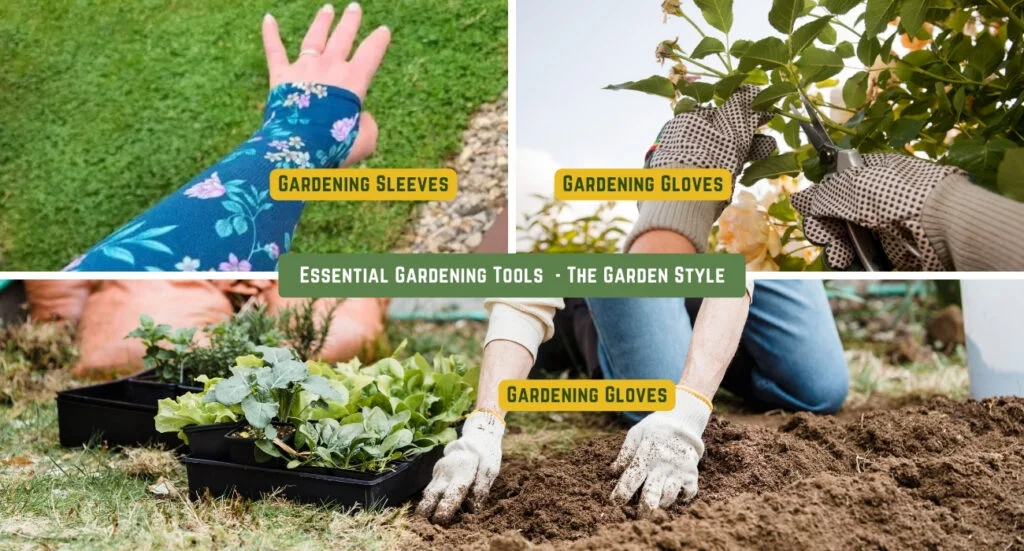
Gardening Gloves
Protect your hands from thorns, dirt, and chemicals with durable gardening gloves. Wear gloves while handling soil and plants, or use other tools to keep your hands safe.
Alternative: work gloves, protective gloves.
A nice addition is wearing gardening sleeves to prevent skin reactions and cuts when working with plants. Some models of gardening sleeves also have UV protection.
Consider gloves with adjustable wrist closures and padded palms for added comfort. Opt for gloves with a snug fit and breathable material for comfort. Safety glasses or goggles are a recommended safety element when pruning and cutting.
Sun Hat and Sunscreen
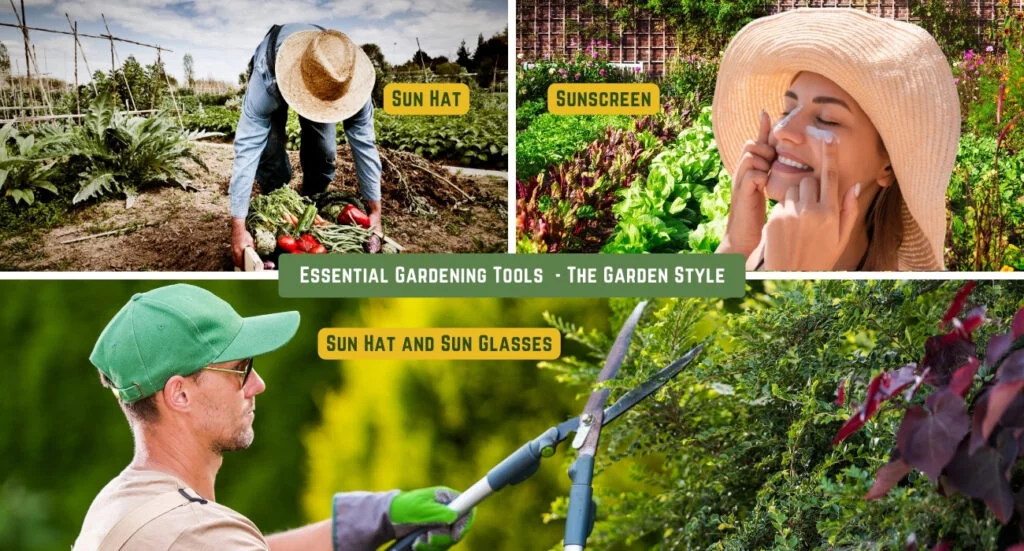
Shield yourself from the sun’s rays during extended gardening sessions. Before going outdoors, don a wide-brimmed hat for sun protection and apply sunscreen to exposed areas. This quick routine shields you from harmful UV rays, keeping your skin safe during outdoor activities.
Look for a hat with UPF protection and broad-spectrum sunscreen for comprehensive coverage.
Kneeling Pads for Gardening
Protect your knees from strain and injury while kneeling or crouching during gardening tasks. Strap the knee pads securely around your knees before engaging in activities that require kneeling.
Tips for choosing the best kneeling pads: choose kneeling pads with ample cushioning, soft foam, thick, water-resistant, and adjustable straps for a comfortable fit.
- GET RID OF HARD ROCK-LIKE KNEELING PADS: This kneeling pad is made with high-density foam to give better and stronger support for knees but feels softer and spongy which makes it more comfortable than others to use even for long-term kneeling work, while the flimsy or stiff ones are not got for anything and even hurt your knees with the rock-like hardness.
More Useful Gardening Tools You May Need
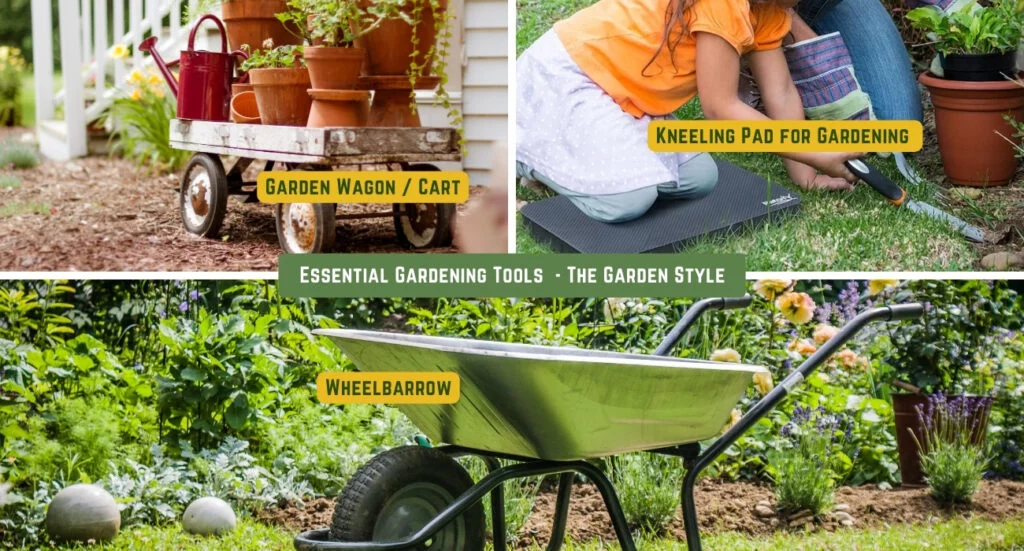
Wheelbarrow
The wheelbarrow is a workhorse for transporting soil, mulch, plants, and other heavy items in the garden. Load your wheelbarrow with materials, lift the handles using your legs, and then push or pull it to where you need it. Keep a steady pace and use the handles for guidance, making transporting heavy loads in your garden a breeze.
Tip: look for a wheelbarrow with a sturdy frame, pneumatic tires, and a comfortable grip for efficient use. Learn how to choose the best wheelbarrows by following the link to our guide.
Alternative: garden cart, yard wagon, heavy-duty trolley.
Garden Wagon or Cart
The garden cart is a versatile tool for hauling larger loads of soil, plants, or other materials. Load the cart, lift the handles, and push or pull it to transport heavy items with ease.
How to choose: Look for a cart with a sturdy frame, large capacity, and pneumatic tires for stability. It is always nice to have a garden cart with a design that allows for easy maneuverability and comfortable handles.
Alternative: utility cart, hauling cart, garden wagon.
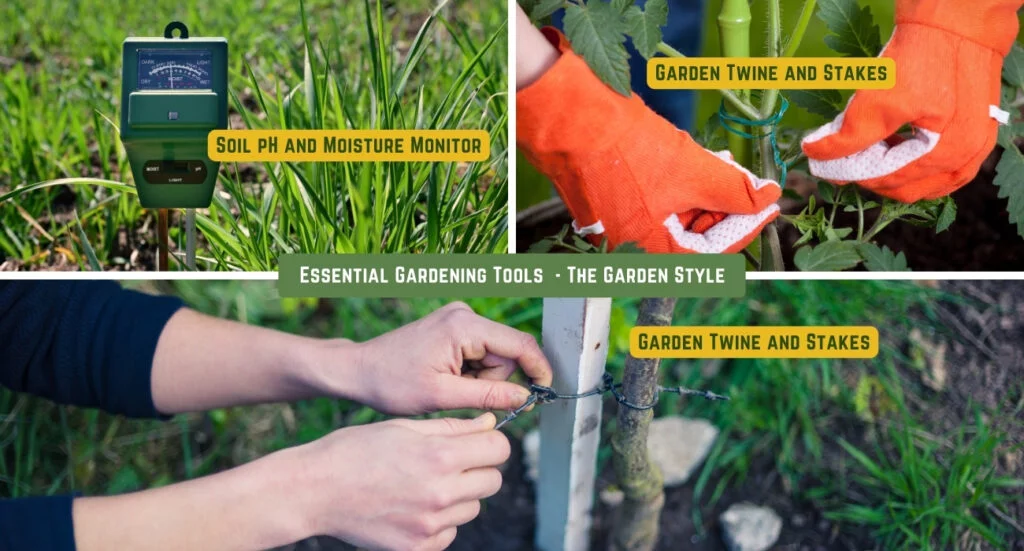
Garden Twine and Stakes
Garden twine and stakes are essential for providing support to plants, securing vines, and creating trellises. Tie the twine to stakes and use them to support plants or create structures for climbing plants.
How to choose: Select easy-to-handle twine with sufficient strength and weather-resistant stakes for long-lasting support.
Alternative: plant twine and supports, gardening string and stakes.
Soil pH Tester
Maintaining the right soil pH is crucial for plant health, and a soil pH tester helps you achieve this. Simply insert the probe into the soil, wait for the results, and adjust pH levels as needed. This straightforward process allows you to monitor and regulate the acidity of the soil for optimal plant health, especially if you are into vegetable gardening. To choose the right one, opt for a digital tester for accuracy and ease of use.
Tips for choosing the best soil monitor: Opting for soil monitors that measure both pH and moisture levels is a smart practice for efficient water management in your garden. These monitors provide valuable insights into the soil’s acidity and moisture content, allowing you to make informed decisions about watering.
String Trimmer and Lawnmower
The essential nature of a string trimmer and lawnmower depends on the specific needs and size of your garden. For more extensive gardens or expansive lawns, a lawnmower becomes essential to efficiently and evenly cut the grass. A trimmer, while not essential for every garden, can be pretty useful for precision trimming in tight spaces or around obstacles that a lawnmower may not reach effectively. If you have a smaller garden or don’t have a traditional lawn, these tools may not be considered essential. It ultimately depends on the layout and scale of your outdoor space and the tasks you need to accomplish in your garden.
Garden Tools for Arthritis
If you are looking for garden tools for arthritis, be sure to check the product descriptions and reviews to ensure that the specific features align with your needs. The ratcheting mechanism in the ratchet pruning shears and any scissors make a difference and substantially reduces the force you need to use to make cuttings and multiplies your hand’s strength.
While ergonomic features are beneficial for individuals with arthritis, they can enhance everyone’s overall user experience. Some of the options mentioned in this article are designed to reduce strain, discomfort, and the risk of injury, making gardening tasks more accessible and enjoyable for all gardeners (regardless of whether they are suffering from arthritis or not).
- Ergonomic Design: Bernini’s Garden Tool Set features a unique vertical grip, providing comfort and ease for all gardeners, especially those with arthritis or grip strength issues
Choosing Wisely: Gardening Tools Chart
Quality Over Quantity. Invest in high-quality tools that may cost a bit more initially but will last longer and perform better.
Ergonomic Design Matters. Prioritize tools with ergonomic designs to ensure comfort during prolonged use.
Here is a chart with our suggested essential garden tools list for beginners that summarizes tips for use, maintenance, and storage.
| Gardening Tool Name | Key Functions | Technique for Use | Maintenance and Storage |
| Garden Cart | Transporting soil, mulch, plants | Tap the rake to remove lodged particles | Clean bed regularly, lubricate wheels annually |
| Garden Fork | Aerating soil, turning compost | Insert tines, push down, rock back and forth | Knock off soil after use, check for rust |
| Garden Hoe | Cultivating soil, breaking clumps | Swing blade to chop and rake topsoil | Clean off debris, file down blade nicks |
| Garden Rake | Clearing debris, smoothing soil | Spraying fertilizer, pesticide, and water | Clean the probe before storing |
| Garden Sprayer | Load, tilt back, push, or pull to move | Fill, pump to pressurize, direct nozzle | Rinse after chemicals, air dry parts |
| Garden Twine/Stakes | Supporting seedlings, vines, stems | Tap the rake to remove lodged particles | Replace brittle twine, clean stakes |
| Gardening Gloves | Handling soil, prickly plants, tools | Check for defects and wear when gardening | Machine wash, line dry |
| Hand Trowel | Planting, weeding, breaking soil | Pull lightly backward over the soil | Rinse off dirt after use |
| Hand Weeder | Pulling weeds and roots | Pull lightly backward over soil | Rinse soil off after use |
| Kneeling Pads | Cushioning knees on hard ground | Secure firmly over knees | Hand wash, air dry |
| Pruner | Trimming plants, deadheading | Open blades, position, apply pressure | Clean and dry after each use |
| Soil pH Tester | Testing and monitoring pH levels | Insert probe in soil, take readings | Push the blade into the soil with foot leverage |
| Spade | Digging holes and trenches | Push the blade into the soil with foot leverage | Rinse off soil after use |
| Sun Hat/Sunscreen | Blocking sun, preventing burns | Push the blade into soil with foot leverage | Wash hat regularly |
| Watering Can | Hydrating gardens and beds | Fill the can, tilt the spout towards the soil base | Rinse out after use |
| Wheelbarrow | Transporting heavy materials | Load cart, tilt to balance, push | Rinse inside, grease wheel annually |
Frequently Asked Questions About Gardening Tools
Some of the most essential tools for beginner gardeners are a trowel, garden fork, hoe, garden shears, shovel/spade, watering can, garden hose, kneeling pad, and gardening gloves. These basic tools will help new gardeners effectively dig, plant, water, weed, prune, and maintain plants.
Seeking out tools with ergonomic, padded handles for comfort and reduced strain is important for those with arthritis or mobility challenges. Lightweight tools are also easier to manage. Some options include ratcheting pruners, ergonomic trowels, tools with gel grip handles, wheeled garden caddies, and comfortable kneeling pads.
The off-season winter months are often the best times to find deals on gardening tools, as retailers discount items to make room for spring inventory. Holiday sales after the gardening season are also good times to keep an eye out for promotions.
Regularly wiping dirt off tools helps prevent rusting. Sharpen pruning shears and hoes annually before the growing season starts. Store tools properly in a dry shed or garage over winter. Periodic oil application also keeps tools working smoothly.
The average lifespan for most garden tool heads (rakes, shovels, etc) is about 5 years with proper care. Pruning shears tend to last about 3 years before dulling. But it’s a good idea to individually inspect/replace any badly worn, damaged, or cracked tools as needed.
While a basic hand trowel can handle various tasks, there are specialized ones for planting, weeding, and transplanting. Choose based on your gardening needs.
Consider the sharpness of the blades, the comfort of the grip, and whether they have a safety lock to prevent accidents.
Aerate your garden at least once a year, preferably in the spring or fall, to promote healthy soil and plant growth.
Digital soil pH testers are more accurate and easier to use, making them a preferred choice for most gardeners.
Choose a broad-spectrum sunscreen with a high SPF and, if possible, one that is water-resistant for prolonged protection during gardening.
Conclusion
Building and maintaining a beautiful garden requires the right tools and equipment. By understanding the functionalities and nuances of these 16 essential gardening tools, you’re well on your way to becoming a master gardener. Remember to choose tools that align with your specific needs and invest in quality for a garden that thrives.
Pin it for later!
